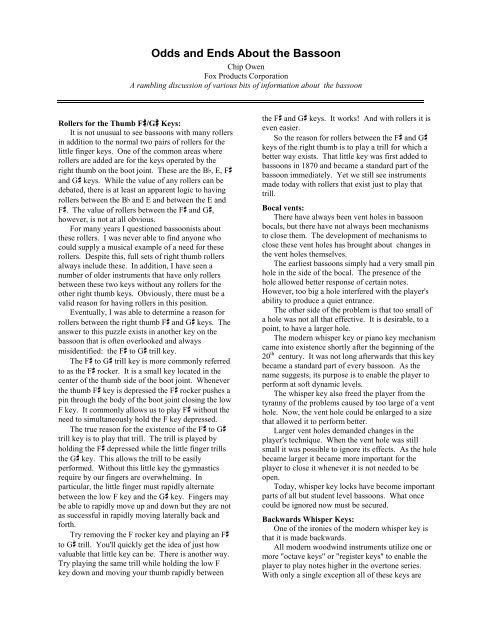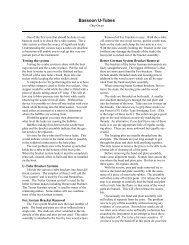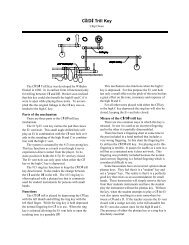Odds and Ends About the Bassoon - Fox Products
Odds and Ends About the Bassoon - Fox Products
Odds and Ends About the Bassoon - Fox Products
Create successful ePaper yourself
Turn your PDF publications into a flip-book with our unique Google optimized e-Paper software.
<strong>Odds</strong> <strong>and</strong> <strong>Ends</strong> <strong>About</strong> <strong>the</strong> <strong>Bassoon</strong><br />
Chip Owen<br />
<strong>Fox</strong> <strong>Products</strong> Corporation<br />
A rambling discussion of various bits of information about <strong>the</strong> bassoon<br />
Rollers for <strong>the</strong> Thumb F'/G' Keys:<br />
It is not unusual to see bassoons with many rollers<br />
in addition to <strong>the</strong> normal two pairs of rollers for <strong>the</strong><br />
little finger keys. One of <strong>the</strong> common areas where<br />
rollers are added are for <strong>the</strong> keys operated by <strong>the</strong><br />
right thumb on <strong>the</strong> boot joint. These are <strong>the</strong> B(, E, F'<br />
<strong>and</strong> G' keys. While <strong>the</strong> value of any rollers can be<br />
debated, <strong>the</strong>re is at least an apparent logic to having<br />
rollers between <strong>the</strong> B( <strong>and</strong> E <strong>and</strong> between <strong>the</strong> E <strong>and</strong><br />
F'. The value of rollers between <strong>the</strong> F' <strong>and</strong> G',<br />
however, is not at all obvious.<br />
For many years I questioned bassoonists about<br />
<strong>the</strong>se rollers. I was never able to find anyone who<br />
could supply a musical example of a need for <strong>the</strong>se<br />
rollers. Despite this, full sets of right thumb rollers<br />
always include <strong>the</strong>se. In addition, I have seen a<br />
number of older instruments that have only rollers<br />
between <strong>the</strong>se two keys without any rollers for <strong>the</strong><br />
o<strong>the</strong>r right thumb keys. Obviously, <strong>the</strong>re must be a<br />
valid reason for having rollers in this position.<br />
Eventually, I was able to determine a reason for<br />
rollers between <strong>the</strong> right thumb F' <strong>and</strong> G' keys. The<br />
answer to this puzzle exists in ano<strong>the</strong>r key on <strong>the</strong><br />
bassoon that is often overlooked <strong>and</strong> always<br />
misidentified: <strong>the</strong> F' to G' trill key.<br />
The F' to G' trill key is more commonly referred<br />
to as <strong>the</strong> F' rocker. It is a small key located in <strong>the</strong><br />
center of <strong>the</strong> thumb side of <strong>the</strong> boot joint. Whenever<br />
<strong>the</strong> thumb F' key is depressed <strong>the</strong> F' rocker pushes a<br />
pin through <strong>the</strong> body of <strong>the</strong> boot joint closing <strong>the</strong> low<br />
F key. It commonly allows us to play F' without <strong>the</strong><br />
need to simultaneously hold <strong>the</strong> F key depressed.<br />
The true reason for <strong>the</strong> existence of <strong>the</strong> F' to G'<br />
trill key is to play that trill. The trill is played by<br />
holding <strong>the</strong> F' depressed while <strong>the</strong> little finger trills<br />
<strong>the</strong> G' key. This allows <strong>the</strong> trill to be easily<br />
performed. Without this little key <strong>the</strong> gymnastics<br />
require by our fingers are overwhelming. In<br />
particular, <strong>the</strong> little finger must rapidly alternate<br />
between <strong>the</strong> low F key <strong>and</strong> <strong>the</strong> G' key. Fingers may<br />
be able to rapidly move up <strong>and</strong> down but <strong>the</strong>y are not<br />
as successful in rapidly moving laterally back <strong>and</strong><br />
forth.<br />
Try removing <strong>the</strong> F rocker key <strong>and</strong> playing an F'<br />
to G' trill. You'll quickly get <strong>the</strong> idea of just how<br />
valuable that little key can be. There is ano<strong>the</strong>r way.<br />
Try playing <strong>the</strong> same trill while holding <strong>the</strong> low F<br />
key down <strong>and</strong> moving your thumb rapidly between<br />
<strong>the</strong> F' <strong>and</strong> G' keys. It works! And with rollers it is<br />
even easier.<br />
So <strong>the</strong> reason for rollers between <strong>the</strong> F' <strong>and</strong> G'<br />
keys of <strong>the</strong> right thumb is to play a trill for which a<br />
better way exists. That little key was first added to<br />
bassoons in 1870 <strong>and</strong> became a st<strong>and</strong>ard part of <strong>the</strong><br />
bassoon immediately. Yet we still see instruments<br />
made today with rollers that exist just to play that<br />
trill.<br />
Bocal vents:<br />
There have always been vent holes in bassoon<br />
bocals, but <strong>the</strong>re have not always been mechanisms<br />
to close <strong>the</strong>m. The development of mechanisms to<br />
close <strong>the</strong>se vent holes has brought about changes in<br />
<strong>the</strong> vent holes <strong>the</strong>mselves.<br />
The earliest bassoons simply had a very small pin<br />
hole in <strong>the</strong> side of <strong>the</strong> bocal. The presence of <strong>the</strong><br />
hole allowed better response of certain notes.<br />
However, too big a hole interfered with <strong>the</strong> player's<br />
ability to produce a quiet entrance.<br />
The o<strong>the</strong>r side of <strong>the</strong> problem is that too small of<br />
a hole was not all that effective. It is desirable, to a<br />
point, to have a larger hole.<br />
The modern whisper key or piano key mechanism<br />
came into existence shortly after <strong>the</strong> beginning of <strong>the</strong><br />
20 th century. It was not long afterwards that this key<br />
became a st<strong>and</strong>ard part of every bassoon. As <strong>the</strong><br />
name suggests, its purpose is to enable <strong>the</strong> player to<br />
perform at soft dynamic levels.<br />
The whisper key also freed <strong>the</strong> player from <strong>the</strong><br />
tyranny of <strong>the</strong> problems caused by too large of a vent<br />
hole. Now, <strong>the</strong> vent hole could be enlarged to a size<br />
that allowed it to perform better.<br />
Larger vent holes dem<strong>and</strong>ed changes in <strong>the</strong><br />
player's technique. When <strong>the</strong> vent hole was still<br />
small it was possible to ignore its effects. As <strong>the</strong> hole<br />
became larger it became more important for <strong>the</strong><br />
player to close it whenever it is not needed to be<br />
open.<br />
Today, whisper key locks have become important<br />
parts of all but student level bassoons. What once<br />
could be ignored now must be secured.<br />
Backwards Whisper Keys:<br />
One of <strong>the</strong> ironies of <strong>the</strong> modern whisper key is<br />
that it is made backwards.<br />
All modern woodwind instruments utilize one or<br />
more "octave keys" or "register keys" to enable <strong>the</strong><br />
player to play notes higher in <strong>the</strong> overtone series.<br />
With only a single exception all of <strong>the</strong>se keys are
closed st<strong>and</strong>ing keys. That is, <strong>the</strong> vent hole operated<br />
by <strong>the</strong> key is normally closed until you take an action<br />
that opens it. Only <strong>the</strong> bassoon's whisper key is open<br />
st<strong>and</strong>ing <strong>and</strong> must be closed by <strong>the</strong> action of <strong>the</strong><br />
player.<br />
The real irony in this is that only a few notes on<br />
<strong>the</strong> bassoon really dem<strong>and</strong> that <strong>the</strong> whisper key vent<br />
hole must be open. Anyone who has tried playing<br />
<strong>the</strong>se notes when <strong>the</strong>ir whisper key lock is set knows<br />
about <strong>the</strong>m. The octave d is probably <strong>the</strong> most<br />
dramatic example of <strong>the</strong> problem. Try playing that<br />
note with <strong>the</strong> whisper key closed.<br />
Look at <strong>the</strong> lengths to which we go to close this<br />
key. In addition to <strong>the</strong> normal touch for <strong>the</strong> left<br />
thumb, <strong>the</strong>re are also several varieties of whisper key<br />
locks, alternate whisper keys for <strong>the</strong> left h<strong>and</strong> little<br />
finger <strong>and</strong> for <strong>the</strong> right h<strong>and</strong> thumb <strong>and</strong> even bridges<br />
to close <strong>the</strong> whisper key whenever <strong>the</strong> high A key is<br />
depressed. And don't forget <strong>the</strong> automatic<br />
mechanism that closes <strong>the</strong> whisper key whenever we<br />
depress <strong>the</strong> low E key so that we can have our left<br />
thumb free to play <strong>the</strong> low note keys on <strong>the</strong> bass<br />
joint.<br />
So why do we go to so much trouble to use a<br />
"backwards" key? The reason probably derives from<br />
having always had an open vent hole in <strong>the</strong> bocal.<br />
Whisper keys were developed as devices to close <strong>the</strong><br />
vent, not to open it. That's what we are used to <strong>and</strong><br />
no maker is foolish enough to try to sell us on<br />
changing.<br />
I have known one bassoonist who made a bassoon<br />
for himself with a closed whisper key. George<br />
Jameson was an interesting repair technician who<br />
also made some unusual instruments. I'm sure <strong>the</strong>re<br />
must have been o<strong>the</strong>r bassoons made with closed<br />
whisper keys but George's is <strong>the</strong> only one with which<br />
I have ever actually had any contact.<br />
Knochenhauer Shape:<br />
<strong>Bassoon</strong> reed makers often refer to <strong>the</strong><br />
"Knochenhauer" shape. Shapers designated with a<br />
"K" have been made to shape cane into this famous<br />
shape. The irony of this is that <strong>the</strong>re really is no<br />
single set of dimensions that define what a<br />
Knochenhauer shape really is.<br />
The gentleman who provided <strong>the</strong> name for this<br />
shape was a German reed maker. He was apparently<br />
quite successful in this.<br />
Unlike modern manufacturers of reeds in volume,<br />
Knochenhauer did not make his reeds with a lot of<br />
machinery. Indeed, his reeds were truly "h<strong>and</strong>made."<br />
This extends to shaping. He shaped all of his<br />
cane by h<strong>and</strong>, without <strong>the</strong> benefit of any type of tool<br />
that guided his knife.<br />
ODDS AND ENDS ABOUT THE BASSOON<br />
2<br />
As a result of his h<strong>and</strong> shaping, <strong>the</strong> actual<br />
dimensions of his shaped cane would vary from piece<br />
to piece. Hence, <strong>the</strong>re is no true set of dimensions<br />
that precisely define a Knochenhauer shape.<br />
Today, we tend to depend on a lot of tools that<br />
haven't always been available. Nobody thinks of<br />
h<strong>and</strong> shaping today. Within <strong>the</strong> last generation <strong>the</strong><br />
use of profiling machines has become so common<br />
that <strong>the</strong> skill of h<strong>and</strong> profiling is quickly becoming<br />
lost.<br />
Despite <strong>the</strong> modern need for all of <strong>the</strong>se special<br />
tools, it can all be done by h<strong>and</strong>.<br />
Swabs & U-tubes:<br />
The type of swab we use today is a result of <strong>the</strong><br />
changes in <strong>the</strong> design of <strong>the</strong> u-tube.<br />
Getting <strong>the</strong> bassoon's boot joint properly swabbed<br />
out in <strong>the</strong> vicinity of <strong>the</strong> u-tube can be a problem.<br />
This is a problem that goes back a long way in <strong>the</strong><br />
history of <strong>the</strong> bassoon.<br />
The early bassoons didn't really have a u-tube as<br />
we know it today. Ra<strong>the</strong>r, <strong>the</strong> bottom end of <strong>the</strong> boot<br />
was closed with a cork plug. Behind <strong>the</strong> cork plug a<br />
connection between <strong>the</strong> two bores was carved that<br />
served as <strong>the</strong> u-tube.<br />
The problem with <strong>the</strong> cork plug is that it was not<br />
easily removed, or replaced. This made effective<br />
cleaning of this area of <strong>the</strong> bore very difficult.<br />
Because of <strong>the</strong> difficulties inherent with <strong>the</strong> cork<br />
plug <strong>the</strong> brass u-tube was developed. The earliest of<br />
<strong>the</strong>se were made for ease of removal. The u-tube<br />
itself was mounted on a brass plate that slid into a<br />
dove-tailed fitting. It was certainly easy to remove<br />
<strong>the</strong> u-tube but it was very difficult to get one of <strong>the</strong>se<br />
dove-tailed u-tubes to seal effectively.<br />
The next development was to mount <strong>the</strong> u-tube<br />
using springs that held <strong>the</strong> u-tube plate against <strong>the</strong><br />
bottom of <strong>the</strong> boot joint. This was definitely an<br />
improvement. The u-tube was still easily removed<br />
<strong>and</strong> it did seal better, but not dependably enough.<br />
The modern u-tube is attached to <strong>the</strong> bottom of<br />
<strong>the</strong> boot by means of threaded studs extending from<br />
<strong>the</strong> bottom of <strong>the</strong> boot joint through holes in <strong>the</strong> utube<br />
plate. Tall nuts secure <strong>the</strong> u-tube onto <strong>the</strong>se<br />
studs. The sealing is now effective, but <strong>the</strong> u-tube is<br />
more trouble to remove.<br />
The traditional swabs that have been provided by<br />
most makers, up until recent times, has been a long<br />
straight stick with a lot of wooly material sticking out<br />
of <strong>the</strong> sides along its length. These push swabs are<br />
intended to be pushed into a bore.<br />
A push swab works adequately until it must stop<br />
at an obstacle. The u-tube of a bassoon's boot joint is<br />
such an obstacle.<br />
The advantage of <strong>the</strong> early dove-tailed u-tubes is<br />
that <strong>the</strong> u-tube could be easily removed so that a push
swab could be used effectively. Even <strong>the</strong> spring<br />
mounted u-tubes were still okay for using with push<br />
swabs, although not as easily as <strong>the</strong> dove-tailed utubes.<br />
When <strong>the</strong> screwed on u-tubes came into existence<br />
<strong>the</strong> push swab when out of date. Unfortunately, it<br />
took most of a century for this fact to become<br />
apparent.<br />
When <strong>the</strong> u-tube is not removed push swabs tend<br />
to push moisture <strong>and</strong> debris into <strong>the</strong> u-tube. This is<br />
an area that must be cleaned properly on a regular<br />
daily basis. Push swabs don't do it.<br />
To effectively remove moisture from <strong>the</strong> u-tube<br />
<strong>and</strong> <strong>the</strong> adjacent bores it is important to use a pull<br />
through swab that is introduced into <strong>the</strong> unlined side<br />
socket, passes through <strong>the</strong> u-tube, <strong>and</strong> is pulled out<br />
<strong>the</strong> lined side socket of <strong>the</strong> boot. In this way, <strong>the</strong><br />
moisture <strong>and</strong> o<strong>the</strong>r debris is effectively removed from<br />
<strong>the</strong> boot joint <strong>and</strong> <strong>the</strong> u-tube <strong>and</strong> <strong>the</strong> adjacent bore<br />
areas are kept clean.<br />
By <strong>the</strong> way, ask any repair technician who<br />
specializes in bassoon repair <strong>and</strong> he'll tell you that he<br />
often sees dents in u-tubes—from <strong>the</strong> inside out! In<br />
addition to overly ambitious use of push swabs some<br />
players have used flute type cleaning rods. This are<br />
metal rods with an eyelet in one end in which a piece<br />
of cloth is inserted. These cleaning rods are<br />
particularly damaging to u-tubes. I've had to replace<br />
u-tubes because <strong>the</strong>y have been perforated by <strong>the</strong>se<br />
rods!<br />
Water in <strong>the</strong> finger holes:<br />
Moisture in <strong>the</strong> finger holes of bassoons, along<br />
with <strong>the</strong> attendant strange gurgling sounds <strong>and</strong> wet<br />
fingertips is a problem that most of us have<br />
experienced. Holding <strong>the</strong> bassoon properly can<br />
largely eliminate this problem.<br />
The source of this problem is in <strong>the</strong> common<br />
habits that most of use develop when we hold our<br />
instruments. <strong>Bassoon</strong> teachers do a good job of<br />
teaching how to form an embouchure <strong>and</strong> blow into<br />
<strong>the</strong> instrument <strong>and</strong> finger <strong>the</strong> notes <strong>and</strong> play <strong>the</strong><br />
music, but rarely do <strong>the</strong>y actually teach how to hold<br />
<strong>the</strong> instrument in a way that avoids moisture<br />
problems in <strong>the</strong> finger holes.<br />
Fundamentally, we play <strong>the</strong> bassoon upside<br />
down. The classic concept of a woodwind instrument<br />
is held in front of <strong>the</strong> player with <strong>the</strong> finger holes on<br />
<strong>the</strong> top side of <strong>the</strong> instrument. A recorder, oboe or<br />
clarinet demonstrates this. On bassoon, because we<br />
hold <strong>the</strong> instrument along our side <strong>the</strong> finger holes<br />
end up on <strong>the</strong> lower side of <strong>the</strong> instrument, close to<br />
<strong>the</strong> flow of moisture in <strong>the</strong> bore. But <strong>the</strong>n we make<br />
<strong>the</strong> problem worse.<br />
It is easier to visualize <strong>the</strong> problem <strong>and</strong> <strong>the</strong><br />
solution if <strong>the</strong> bass joint is removed from <strong>the</strong><br />
ODDS AND ENDS ABOUT THE BASSOON<br />
3<br />
instrument. Assemble <strong>the</strong> wing <strong>and</strong> boot joint as well<br />
as <strong>the</strong> bocal <strong>and</strong> reed <strong>and</strong> hold it as if you were<br />
playing <strong>the</strong> instrument.<br />
The problem occurs whenever we pause in our<br />
playing. The common habit is to rotate <strong>the</strong> bassoon<br />
so that <strong>the</strong> broad side of <strong>the</strong> boot joint lays flat<br />
against <strong>the</strong> leg. In this position <strong>the</strong> bocal would be<br />
pointing toward <strong>the</strong> player's right. The finger holes<br />
are now in <strong>the</strong> worst possible position. Any moisture<br />
in <strong>the</strong> bore heads straight for <strong>the</strong> finger holes. Tubes<br />
inserted into <strong>the</strong>se finger holes <strong>and</strong> protruding<br />
slightly into <strong>the</strong> bore help avoid <strong>the</strong> problem but don't<br />
always succeed.<br />
The way to avoid moisture problems is simply a<br />
matter of changing <strong>the</strong> way we hold our instrument<br />
whenever we pause in our playing. Instead of<br />
rotating <strong>the</strong> instrument so that <strong>the</strong> bocal points to<br />
your right, reverse <strong>the</strong> rotation so that <strong>the</strong> bocal<br />
points to your left. As you will see, <strong>the</strong> finger holes<br />
are now positioned high <strong>and</strong> dry.<br />
Of course, nothing comes free. At first this<br />
different rotation will seem strange <strong>and</strong> awkward.<br />
Also, your reed will end up in a somewhat more<br />
vulnerable position. It may take you a little while to<br />
get familiar with this. When you have developed this<br />
into a habit you will find that moisture in <strong>the</strong> finger<br />
holes is no longer a problem.<br />
What Temperature do you tune at:<br />
Temperature can have an effect on <strong>the</strong> pitch at<br />
which you play.<br />
The frequency of any sound is determined, in<br />
part, by <strong>the</strong> speed of sound. In a comfortably warm<br />
room <strong>the</strong> speed of sound is 345 meters per second.<br />
However, <strong>the</strong> speed of sound is directly affected by<br />
<strong>the</strong> temperature of <strong>the</strong> air. That is, when <strong>the</strong><br />
temperature is lower, <strong>the</strong> speed of sound will be<br />
slower <strong>and</strong> <strong>the</strong> resulting frequency of pitches played<br />
at that lower temperature will be flatter. In a similar<br />
way, we can expect pitches at a higher temperature to<br />
be sharper.<br />
This has some interesting social aspects.<br />
Instruments made in Europe traditionally have been<br />
tuned to yield a pitch at 68°F while instruments made<br />
in America have been tuned to yield a pitch at 72°F.<br />
It seems that <strong>the</strong> central heating that came to America<br />
before it was used in Europe has produced a<br />
population that enjoys its comforts. As a result, <strong>the</strong><br />
instruments we use must also reflect <strong>the</strong> same<br />
comforts.<br />
One G' Tone Hole or Two:<br />
A question that often gets asked concerns <strong>the</strong><br />
designs of <strong>the</strong> thumb G' on bassoons. On some<br />
instruments <strong>the</strong>re are two separate tone holes for <strong>the</strong><br />
little finger G' <strong>and</strong> for <strong>the</strong> thumb G'. On o<strong>the</strong>r
instruments <strong>the</strong>re is only a single tone hole operated<br />
by both keys.<br />
The reasons for <strong>the</strong> two systems has to do with<br />
<strong>the</strong> evolution of tuning as well as mechanics.<br />
The two hole G' system is <strong>the</strong> older of <strong>the</strong> two.<br />
The objective of this system is to offer different<br />
tunings for A( <strong>and</strong> G'. While modern usage has<br />
largely forgotten that <strong>the</strong>se are two different notes, in<br />
reality <strong>the</strong>y are different. Note that I am ra<strong>the</strong>r<br />
casually referring to <strong>the</strong>m both as G' tone holes; I<br />
could also be referring to <strong>the</strong>m both as A( tone holes.<br />
The difference is older than <strong>the</strong> modern equal<br />
tempered scales that are necessary for modern<br />
omnitonic instruments to be playable in all scales.<br />
Earlier temperaments produced clearly different<br />
pitches for <strong>the</strong> two notes. However, early<br />
instruments based on <strong>the</strong>se temperaments were not<br />
capable of playing well in all scales. Instead of<br />
playing a few tonalities correctly, <strong>the</strong> modern equal<br />
temperament succeeds by playing all scales equally<br />
badly.<br />
An important analogy to <strong>the</strong> two separate G' tone<br />
holes comes from <strong>the</strong> flute. Early flutes did not have<br />
any keys. J. J. Quantz, one of <strong>the</strong> early developers of<br />
<strong>the</strong> flute added <strong>the</strong> first key to <strong>the</strong> flute: <strong>the</strong> D' key.<br />
He also added <strong>the</strong> second key: <strong>the</strong> E( key. Of all <strong>the</strong><br />
keys he could have added he chose to add keys for<br />
what today we would consider <strong>the</strong> same note. For<br />
him in that time <strong>the</strong>y were significantly different.<br />
Times have changed, however. Today<br />
instruments are made to be omnitonic. That is, <strong>the</strong>y<br />
must be capable of playing in all keys. As a result<br />
<strong>the</strong> difference between <strong>the</strong> little finger G' <strong>and</strong> <strong>the</strong><br />
thumb G' tone holes has evolved to a level where we<br />
don't notice it.<br />
Now that we have become satisfied with any G'<br />
tone hole <strong>the</strong>re is little musical reason to have two.<br />
Eliminating one of <strong>the</strong>m eliminates one pad that<br />
might leak. It's not to difficult to produce a<br />
mechanism for <strong>the</strong> thumb G' key that operates <strong>the</strong><br />
pad on <strong>the</strong> little finger G' key. So what if we lose<br />
out on a tuning detail—we don't use it today anyway.<br />
Of course, not everything comes without a price<br />
somewhere. The volume of air within any tone hole<br />
is a part of <strong>the</strong> bore of <strong>the</strong> instrument. Simply<br />
removing a large tone hole constitutes a change in <strong>the</strong><br />
bore design. It's not always a good idea to simply<br />
discard part of a successful design to casually. As a<br />
result we continue to make all of our long <strong>and</strong> short<br />
bore models with two hole G' systems at <strong>the</strong> same<br />
time we make our thick wall models with single hole<br />
G' systems. Don't bo<strong>the</strong>r asking us to make <strong>the</strong> o<strong>the</strong>r<br />
G' system any given model—we won't.<br />
Revised October 17, 2001<br />
ODDS AND ENDS ABOUT THE BASSOON<br />
4








